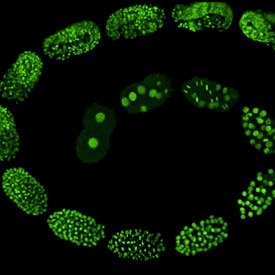Ambitions of a Tool-Maker
Hari Shroff and his team build microscopes that shine light on the boundaries of neuroscience.

Photoactivated localization microscopy (PALM) image of the proteins paxillin and zyxin
Hari Shroff, Ph.D., shakes his head in disbelief. “It just blows my mind that this hasn’t already been done,” he exclaims, proceeding to outline his vision for a project so grand in scale that one can almost understand why no one has attempted it—Shroff wants to create a four-dimensional atlas of brain development during embryogenesis in simple organisms, tracking the origin and evolution of every neuron, the path of every axon, and the creation of every synapse. Such comprehensiveness has always been Shroff’s approach.

Research fellow Yicong Wu, Ph.D., adjusts a SPIM microscope
At the tender age of 14, Shroff entered the University of Washington to begin undergraduate studies in bioengineering. He enrolled in the University of California, Berkeley graduate program in biophysics at 19 and completed his Ph.D. in 2006 at the age of 25. He describes his accelerated educational experience as a fun time, where he deliberately chose to study a smorgasbord of subjects, embracing complex courses in physics, engineering, and molecular biology. He spent his postdoctoral years at the Howard Hughes Medical Institute’s Janelia Farm Research Campus addressing the factors that limit resolution in light microscopy. His research used photoactivated localization microscopy (PALM), an optical superresolution technique invented by Eric Betzig, Ph.D., and Harald Hess, Ph.D., that allows biologists to discern the precise location of individual proteins within a cell. Shroff was impressed with PALM, and worked to extend the technology, applying it to live cells and to the use of probes of different colors.

Selective plane illumination microscopy (SPIM) images of a developing C. elegans embryo
Now at the NIH’s IRP, Shroff has continued to develop PALM, adapting it for 3D imaging in thicker samples. His interests have also branched out to include microscopes with high temporal as well as high spatial resolution. An example of the latter is an adaptation of a type of microscopy called selective plane illumination microscopy, or SPIM, which Shroff and Yicong Wu, Ph.D., designed, built, and tested in their lab at the National Institute of Biomedical Imaging and Bioengineering (NIBIB). SPIM uses planes of light to visualize specimens—an approach that is much less damaging to the specimens than conventional microscopy techniques.

Microscope view of the nematode worm Caenorhabditis elegans
That’s important because it allows scientists, for the first time, to view fluorescently labeled proteins within living worms throughout a complete cycle of embryogenesis. “It’s humbling to think that with current knowledge and technology, we still know so little about neurodevelopment, about how the brain becomes wired,” says Shroff. “There are an estimated hundred billion neurons in the human brain—and a hundred trillion synapses— but we just don’t know how this incredibly precise connectivity is orchestrated. If we can use SPIM to create a four-dimensional atlas of neurodevelopment in simple organisms, this may give a better understanding of that process.”

Shroff, winner of the 2010 PECASE award
Shroff is collaborating with Drs. Daniel Colon-Ramos (Yale University) and Zhirong Bao (Memorial Sloan- Kettering Cancer Center) to develop a 4-D atlas of the worm model, C. elegans. Even though C. elegans is a relatively simple organism, it nevertheless has 302 neurons and 5,000 synapses, so creating a 4-D atlas of it is an ambitious undertaking. Using fluorescent marker molecules to highlight single cells, Shroff and his collaborators can now watch as individual neurons develop over an eight-hour period within a living worm embryo. He is already planning how to improve and scale initial findings so that the C. elegans atlas can be completed in a shorter time frame.
In recognition of his innovative work, Shroff won a 2010 Presidential Early Career Award for Scientists and Engineers (PECASE). Not one to dwell on prizes, Shroff describes himself as a ‘tool-maker’ who finds his greatest satisfaction when others discover new applications for the technologies that he and his collaborators develop.
Hari Shroff, Ph.D., is the Chief of the Section on High Resolution Optical Imaging at the National Institute of Biomedical Imaging and Bioengineering (NIBIB).
This page was last updated on Wednesday, May 24, 2023